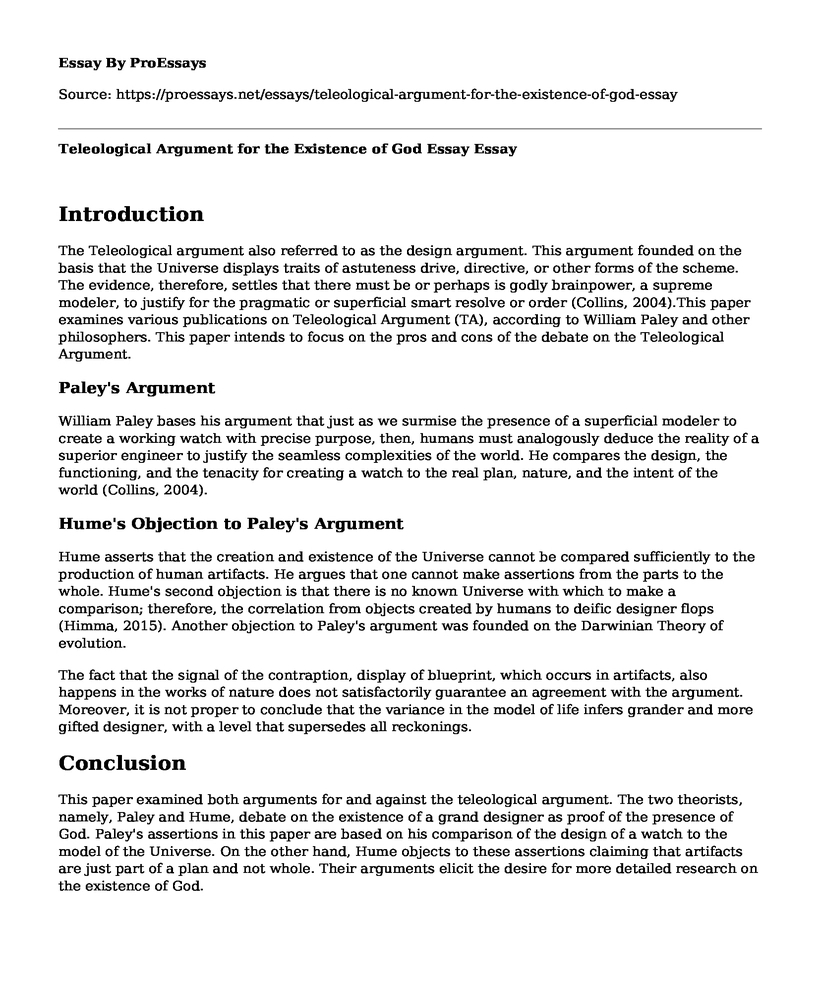Introduction
The Teleological argument also referred to as the design argument. This argument founded on the basis that the Universe displays traits of astuteness drive, directive, or other forms of the scheme. The evidence, therefore, settles that there must be or perhaps is godly brainpower, a supreme modeler, to justify for the pragmatic or superficial smart resolve or order (Collins, 2004).This paper examines various publications on Teleological Argument (TA), according to William Paley and other philosophers. This paper intends to focus on the pros and cons of the debate on the Teleological Argument.
Paley's Argument
William Paley bases his argument that just as we surmise the presence of a superficial modeler to create a working watch with precise purpose, then, humans must analogously deduce the reality of a superior engineer to justify the seamless complexities of the world. He compares the design, the functioning, and the tenacity for creating a watch to the real plan, nature, and the intent of the world (Collins, 2004).
Hume's Objection to Paley's Argument
Hume asserts that the creation and existence of the Universe cannot be compared sufficiently to the production of human artifacts. He argues that one cannot make assertions from the parts to the whole. Hume's second objection is that there is no known Universe with which to make a comparison; therefore, the correlation from objects created by humans to deific designer flops (Himma, 2015). Another objection to Paley's argument was founded on the Darwinian Theory of evolution.
The fact that the signal of the contraption, display of blueprint, which occurs in artifacts, also happens in the works of nature does not satisfactorily guarantee an agreement with the argument. Moreover, it is not proper to conclude that the variance in the model of life infers grander and more gifted designer, with a level that supersedes all reckonings.
Conclusion
This paper examined both arguments for and against the teleological argument. The two theorists, namely, Paley and Hume, debate on the existence of a grand designer as proof of the presence of God. Paley's assertions in this paper are based on his comparison of the design of a watch to the model of the Universe. On the other hand, Hume objects to these assertions claiming that artifacts are just part of a plan and not whole. Their arguments elicit the desire for more detailed research on the existence of God.
References
Collins, R. (2004). The teleological argument. In the Rationality of Theism (pp. 144-160). Routledge. https://www.readkong.com/page/the-teleological-argument-an-exploration-of-the-8062610
Himma, K. E. (2015). Design arguments for the existence of god. Design Arguments for the Existence of God," Internet Encyclopedia of Philosophy (James Fieser, ed.). https://www.academia.edu/13845677/Design_Arguments_for_the_Existence_of_God
Cite this page
Teleological Argument for the Existence of God Essay. (2022, Mar 24). Retrieved from https://proessays.net/essays/teleological-argument-for-the-existence-of-god-essay
If you are the original author of this essay and no longer wish to have it published on the ProEssays website, please click below to request its removal:
- Paper Example on Divorce in Sharia Law
- Daniel Talks About King Nebuchadnezzar's Dream Paper Example
- Image of Islam and Muslim in the West Paper Example
- Essay Example on Christianity Debate: Jonathan vs Alex - The Resurrection
- Paper Example on Christian Theology: An Overview of Its History and Purpose
- Essay Example on Septuagint: Ancient Greek Translation of the Bible
- Essay Example on Women in Evangelism and Faith-Based Leadership: A Theological Discourse







